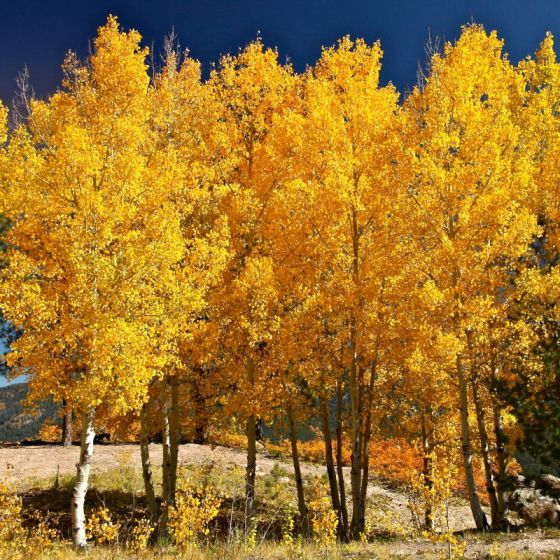✖
Quaking Aspen Tree
Populus tremuloides
As low as
$159.40
In stock
SKU
PFY-437
Gorgeous Quaking Aspen Tree
- Fast-Growing Native Plant
- Wonderful Leaves and Bark
- Useful Pyramidal Shape
- Beautiful Fall Color
Quaking Aspen trees (Populus tremuloides) are gorgeous, fast-growing native trees distributed over most of North America, including the United States and Canada. You may have seen and loved them in National Forests throughout the Rocky Mountains. They are a pioneering species of trees that are one of the first trees to invade open areas and prairies.
There is nothing like hearing the wind rustling through a group of Aspen trees on a summer day.
One of the most endearing features of Quaking Aspen is that their heart-shaped leaves quake and flutter back and forth with the slightest of breezes, making a soft sound like rain. The sounds of the leaves blowing through a native stand of Aspen has been admired and memorialized by poets and writers alike.
Distinctive Leaves and Lovely Fall Color
Quaking Aspen grow tall and somewhat pyramidal in their outline when young and may be mistaken for Birch. As these trees age, they can develop a more rounded form.
Aspen have heart-shaped leaves that are dark green on top and lighter colored on the underside. The Quaking Aspen is a deciduous tree and will lose its beautiful leaves in fall.
In the fall, the leaf colors turn an incredibly clear yellow color. While yellow is the most typical fall color you'll see, native stands can exhibit some orange and even pockets of red. It's vibrant in the landscape and makes a big statement.
The bark on young Aspen trees may not show the classic light color, but once they hit a couple of inches in width (or caliper), they turn a lovely chalky greenish white color. The beautiful smooth, white bark from Quaking Aspen trees was used by pioneers and American Indians for medicinal purposes.
How To Use Quaking Aspen Trees in Your Landscape
Quaking Aspen can be used as a specimen tree in a lawn area where it can easily be maintained. Or you can plant Aspen trees mixed in clumps and single stem plants in natural groups.
Use Quaking Aspens to create a sense of enclosure without feeling like you live in a fortress. Create a respite from the modern world with a loose, zig-zagging row of several of these trees. Pro tip? Leave enough space when planting to wind a mulched nature trail between them.
Plant them in a gentle curve around an out-of-the-way spot in your backyard. What a magical, private place to put a hammock. Aspens also make incredible "vistas" or views from your deck or patio. Nature can be brought home and enjoyed to the fullest with wonderful native trees like this one. Try your hand at landscaping to gift yourself a real sense of peace on your property.
Long-Lived Wildlife Tree
Aspen trees are also an excellent tree species for wildlife habitats in full sun. The ruffled grouse feed on the catkins and buds, and elk and deer feed on the leaves in fall and winter. Butterflies, moths and caterpillars also feed on the leaves.
These adaptable trees love a rich, humusy soil that is consistently moist, but they grow naturally in dry and rocky soils in the Rocky Mountains. Their tolerance of soil types is one of the reasons this tree is so widely distributed.
Aspen can be very successfully incorporated into today's more natural landscapes where they can support plenty of wildlife.
We sell out of this beautiful native tree. If it's in stock, please place your order today!
| Botanical Name | Populus tremuloides |
|---|---|
| Mature Height | 40 - 50 feet |
| Mature Spread | 20 - 30 feet |
| Soil Type | Widely Adaptable |
| Sun Exposure | Full Sun |
| Growth Rate | Fast |
| Bloom Period | Early Spring |
| Fall Color | Yellow |
| Pollinator Required | No |
| Pollinator Friendly | Yes |
| Growing Zone Range | 2-6 |

Write Your Own Review

